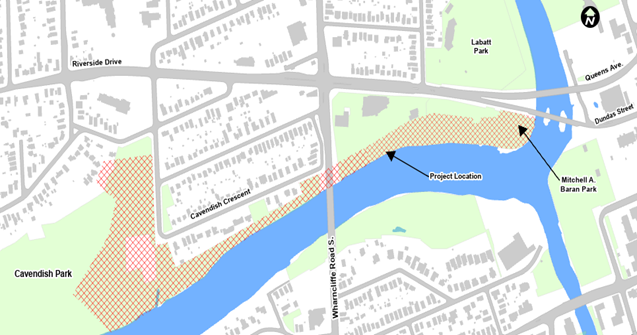Project background:
The City of London, in partnership with the Upper Thames River Conservation Authority (UTRCA), is rebuilding the West London Dyke between Cavendish Park and Kensington Bridge. The West London Dyke is a 2,300-meter-long flood protection structure along the Thames River. It helps prevent flooding and is also part of the City’s recreational pathway system. The City owns the dyke, while UTRCA handles major maintenance. From 2007 to 2023, the City and UTRCA upgraded the dyke between Oxford Street West and Kensington Bridge to withstand a 250-year flood.
Public update meeting:
The City of London hosted an in-person open house on Thursday, May 8, 2025, to share project details and gather feedback from residents. To view the boards from the meeting, click here.

Above: Project Limits of Phase 9-13 of the West London Dyke Reconstruction
Upcoming construction:
Stantec Consulting has designed the next phase of the West London Dyke reconstruction, from Cavendish Park to Kensington Bridge.
The project will start with an earth berm at Cavendish Park, then change to a reinforced vertical wall near Wharncliffe Avenue Bridge and finally return to an earth berm through Mitchell A. Baran Park to Kensington Bridge.
An earth berm is a raised, sloped mound of compacted soil. It is often used for flood protection, erosion control, noise reduction, or landscaping.
Construction will also include a new hand railing, a pedestrian pathway, and landscaping as part of the Thames Valley Parkway extension.
Bicyclists and pedestrians should expect detours along the Thames Valley Parkway during construction.
The City is finalizing the project design and assessing tree impacts. Tree removal will begin in Fall 2025. Some trees may need to be removed due to their location, health, or safety concerns, but the City will preserve as many as possible.




